
What is mined in Mexico – minerals such as selenite, moonstone, apatite and calcite. These days, however, it’s not wise to go rock hunting alone in Mexico without making prior arrangements with someone local. Here’s a personal account of Mexican rockhounding adventures in days past…
Traveling to tourist areas is okay, but heading into the mountains and to remote mining areas doesn’t seem too smart to me. In the good old days, we thought nothing of loading up our gear heading across the border. In those days, I was on the governing board of the Arizona-Sonora Desert Museum and Bill Panczner, my frequent collecting partner, was the head of the museum’s mineral department.
Our trips to Mexico were always multipurpose. We were always on the lookout for specimens for the museum. We also collected for ourselves. And more importantly, Bill was committed to writing a book, Minerals of Mexico published in 1987 and still available online. We made both month-long camping trips alternated with hotel visits and short-term trips with only an overnight or two and one or two goals in mind.
A New Selenite Cave
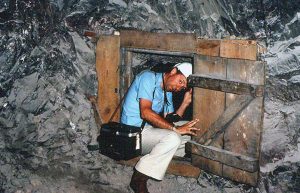
For one trip, Bill heard a new selenite cave had been breached during mining at the Buena Tierra mine. It so happened our museum was constructing an Earth science wing and Bill had planned a replica mine tunnel as part of it. The tunnel wall would have several mineral pockets featuring vanadinite, malachite and wulfenite plus a small selenite cave. When we heard about the new cave we headed south.
The Buena Tierra mine is in the mountains east of Chihuahua City. We went to the superintendent’s office and introduced ourselves. My son, Evan, and Bill’s son, Chris, were with us. We asked Superintendent Ibarra about the new cave and he denied its existence, but later agreed to take us in it.
The cave had been breached during the digging of a big incline for trucks to haul ore from a lower level. After a hike down the incline, we came to a solid timber wall on one side with a small 30-inch square door access to the cave. The super unlocked the small door and Evan crawled in. As I started in I heard Evan say, “Dad, this is just like science fiction!” And it was! He was in a cavern about 25-feet wide and high that extended maybe 75 meters or more. The entire floor was covered with perfect two-inch monoclinic selenite crystals sticking up.
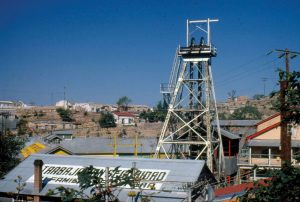
We walked in others’ tracks to avoid doing damage to explore the cave. Hanging from the sidewalls and ceiling of the cave were huge broad snow-white stalactites of gypsum with tiny purple fluorite cubes scattered on them. This was showy stuff but the real show was several dozen free-standing diverging sprays of five-foot selenite crystals each several inches thick. Evan had been right. It was just like science fiction.
On a later trip, I took a tape measure. One fallen crystal measured 13 feet! We were not allowed to collect even the fallen crystals but I must admit one loose crystal somehow “jumped” into my camera bag! On our third trip, we were allowed to collect one crystal each. I also noted the Superintendent’s home fireplace had selenite “logs” stacked on it.
The purpose of our later visits was to negotiate for a crystal spray we might collect for use at the Desert Museum. The plan was to mount it at the entrance to the new science building. Unfortunately, Bill was never successful in getting permission to collect a spray. More disappointing, when mining began on the lower levels beneath the cave, it caused all the selenite crystals to cleave and fall. At the Tucson Show the next year, there were miners from that area carrying five-foot selenite crystals like rifles selling them.
An Exposed Selenite Crystal Pocket
Benny and Elva Fen were dealers and good friends. Originally from Colonia Juarez, they had a home there and a home and mineral business in Las Cruces, New Mexico. They had lots of contacts in Mexico who kept them supplied with good minerals. Benny was often contacted when a mineral find was made. One rancher stumbled on a selenite crystal pocket that had been exposed on the side of a wash after heavy rain. The fellow knew the crystals had value so he contacted Benny for help, something that often happened as Benny had a great reputation. Benny checked out the find and helped the fellow and his partners develop the pocket which opened into a small cave lined with crystallized selenite. On one trip, Carol and I with Benny and Elva went to the cave so Benny could check on cave progress.
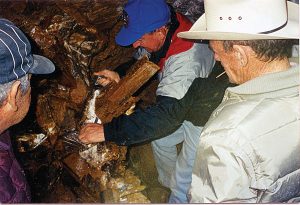
The miners had opened the cave large enough to hold several people. When we got there they had already installed concrete steps down into the cave and were collecting crystals off the walls mainly using hack saws. One partner had a large leather bag on his back with a headband like early miners used to haul ore centuries ago. He insisted on hauling the heavy crystals that way, though Benny had offered to set up a winch. Benny and I climbed into the cave and the miners insisted I collect my own selenite crystal. They handed me a hack saw and I did the job cutting a nice ten-inch-long selenite. Benny told me later the cave was not as large as they had hoped, but they collected all the crystals and were happy.
Seize the Opportunity!
You never know when you may have an opportunity to acquire minerals. Even a chance meeting is all it takes. That happened to my son, Evan. He met the daughter of a Mexican rancher whose property bordered the new Milpillas copper mine. She saw an azurite Evan had and said her father had something like that! This led Evan and me to visit the rancher in Mexico because the rancher had a mine connection.
Traveling into Mexico was okay as long as you had local contacts to accompany you. Our visit was one of the first by American collectors and proved productive. A connection was made and now many are familiar with the amazing azurite, malachite, brochantite, malachite ps. azurite and several rare species that came from the Milpillas mine. It has produced world-class specimens of these minerals in quantity. Since our first trip into the mine, Evan has new access to some of the world’s best azurites.
When we made our first trip to the Milpillas mine, we made arrangements for the rancher’s sons to meet us at the border near Nacco-Bisbee. We convoyed the 30 or so miles to the ranch on local roads. The interesting part of that drive was on a local road just wide enough for two cars to pass as it staggered down a hillside. Meeting a truck was another matter. If a truck broke down on the hill, the truck driver would turn traffic officer and direct traffic until the truck was fixed.
At the ranch, we had nice a visit before looking at six flats of minerals. There was a flat of pyrite crystals from the Maria mine and five flats of fine malachite after azurite pseudos. The color was excellent and so was the velvety luster. The crystals were miniatures to small cabinet specimens, all in great condition.
It helped that Evan could speak some Spanish and he agreed to buy the lot. We made a deal with the rancher but did not load up the minerals and head home. After paying for the specimens, we left them and drove back to Arizona after making arrangements for the rancher to bring the specimens across the border, something his family often did to shop.
We met in a grocery store parking lot in Nacco, got our minerals and headed home. This arrangement led to subsequent trips to Milpillas and subsequent negotiations. For a couple of years after that, Evan was nicknamed “Mr. Azurite” as he and the rancher handled many of the best specimens from Milpillas. Every major specimen of high value required a border crossing and negotiations mainly in Spanish. But I got to photograph some of the best azurites to come out of the ground in the last 75 years.
A Gem Moonstone Deposit
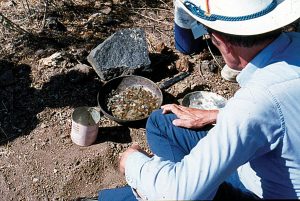
Another trip Evan and I made into Mexico with Benny Fenn and Bill Panczner was to check out a gem moonstone deposit. As often happens, locals had come across some interesting minerals and contacted Benny for advice and help. They had found a hillside lava flow with a two-foot wide seam of crystallized feldspar. The seam extended horizontally across the face of the flow for maybe 100 yards. They had concentrated on one area carving out a shallow cave. They mined one and two-inch crystallized feldspar that had a bright multi-color schiller moonstone effect in all the crystals.
When we got there, the miners had been busy and had several pots and frying pans filled with rough gems ready for Benny to check. Evan and I got into the shallow opening and enjoyed digging feldspar crystals that showed a nice schiller effect. Normally I do not collect at a dig where locals are working for profit. But in this case, I had traced the crystallized moonstone seam across the lava outcrop for over 100 yards, so I figured digging a few crystals would be okay. I gave away the stones I got and Evan made a small trade with his.
What is Mined in Mexico? – Pegmatite Deposits
The pegmatite mines of Southern California are well known for the gems they have produced. Not so well known are the pegmatite deposits associated with the same huge underlying batholith that extends south into Baja California Norte, Mexico.
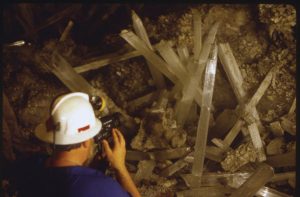
One of these deposits, Mina la Verde, produced fine elbaite tourmaline associated with large danburite crystals.
This association raised a question about the identity of Baja elbaite, a complex sodium, lithium and aluminum borosilicate. Finding danburite, a calcium boron silicate, attached to some Mina La Verde elbaite crystals made some wonder if the identified elbaite was instead liddicoatite. This is a tourmaline that looks like elbaite except its major metal cation is calcium, not sodium.
As a consequence, I was approached by the editor of Mineralogical Record and asked if I would join California mineral dealer, Cal Graeber, and go to Baja to check things out.
He did not have to ask twice!
Cal and I, accompanied by a gem dealer from Los Angeles, drove into Mexico using directions supplied by our friend, Josie Scripps. Josie had financed the mining of Mina La Verde so she was part of our investigation.
We camped out at the mine and spent a day there, but never found elbaite or danburite. When we returned, Josie gave me a polished slice of elbaite cut from an earlier Mina La Verde dig. I had it micro-probed at the Sandia Lab in New Mexico. No calcium was found, proving it was elbaite but with 2% zinc in it.
What is Mined in Mexico? – La Fe Calcite Mine
 On another trip, Evan and I, with Bill and Chris Panczner, went to the La Fe Calcite Mine in Durango. The mine was operational during World
On another trip, Evan and I, with Bill and Chris Panczner, went to the La Fe Calcite Mine in Durango. The mine was operational during World
War II for optical grade doubly refractive calcite. The calcite was sliced and used in the Norden bombsight in the B-29 bombers I worked on.
The calcite vein was in a wide vent in volcanic rock. Calcite-rich hydrothermal waters had surged into the vent and crystallized. The solution was pure calcium carbonate.
As it cooled, it formed a layer of crystallized optical-grade calcite at least two inches thick on the walls of the vent. Later, the calcite solutions crystallized on top of the optical calcite layer with huge crystal clusters that grew in broad subparallel fan-like opaque blades.
Miners had to pry these bladed calcites off the walls to reach the optical calcite. When we were there, huge sections of bladed calcite were all over the floor for the taking. Some were too heavy to lift! The only time you used a hammer was to make small calcite crystal groups out of big sheets of calcite crystals. Needless to say, we were contented when we camped at the foot of the hill that night.
Collecting Yellow Apatite Crystals
Before the calcite dig, we had been to Durango’s Cerro de Mercado Mine, a huge iron ore deposit, to collect yellow apatite crystals.

I can recall going to mineral shows year after year and seeing dealers offering small trays filled with bright yellow single fluorapatite crystals, never on matrix with one end broken and the other well terminated. The crystals were never more than an inch or two long but gemmy. We just had to go to Cerro de Mercado!
As we drove the mine road, we could see yellow crystals in the gravel so we stopped and collected them.
I ended up stuffing my pockets with crystals before getting to the mining operation. What better way to get my students interested in minerals at school than to hand them bright yellow gemmy crystals?
There is no estimate of how many fluorapatite crystals occur at this deposit. It is countless millions, but you seldom see a good matrix fluorapatite specimen.
Fresnillo Silver Mine
At the Tucson Show, a friend of mine bought a small specimen of stibnite crystals labeled Fresnillo, Chihuahua, Mexico. Fresnillo is a silver mine known for a nice variety of minerals but I had never seen crystallized stibnite from there.

Later that spring Bill and Chris Panzcner, my son Evan and I did a month-long camping trip and included Fresnillo to check out the stibnite. The night before we got to the mine, we camped at Oroganos Park, a fairyland of rhyolite towers, jagged cliffs and spectacular scenery. John Wayne’s movie War Wagon had been shot there.
From there, we headed to Fresnillo and checked in with the superintendent. He had never seen any stibnite but was willing to take us underground to look for it. He escorted us down the incline and we walked the main tunnel toward the mining operation. The miners were using a cut and fill method. They drilled and blasted the ceiling down and the ore was taken by a front loader to the conveyor. The slimes from the mill were pumped down forming the floor where the miners worked.

As we were walking along the main tunnel, we saw bits of stibnite on the floor. High on the wall was a nice big pocket of stibnite crystals, but we had no ladder. The superintendent said nothing but walked off and came back followed by a guy driving a front-end loader. Chris and Evan got in the loader bucket and were hoisted up so they could work the pocket. It dawned on me we were doing things backward. I made the boys come down so Bill and I could collect for the Museum. We had a self-imposed agreement that when we collected a pocket of crystals we could each have one specimen, but the bulk of the find was for the Museum.
Stibnite is a fragile mineral and we had not expected to collect on this scouting walk.
Luckily, paper and empty blasting powder boxes were scattered around. We packed the stibnite in a couple of boxes. Big mistake!
As we finished, there was a shift change and along came a tram loaded with miners being pulled by a tractor heading up the incline. We hopped on with our boxes of crystals. As soon as we did, the miners all got off and started walking out of the mine. They thought we were hauling explosives! Once we showed them the stibnite, they got back on the ram.
What is Mined in Mexico? – Collecting Selenite
I was a dealer chairman for the Tucson Show one year and we had a letter from a person wanting a dealer space. He had enclosed a photo of enormous selenite crystals, so I called him. He told me about the big crystals so I asked if he could get me in the cave and he agreed.

A month or so after the show, Carol and I joined him and headed to the silver mine at Niaca. At the mine office, we met a miner guide, got hard hats and headed to a truck that would drive us down a spiraling inclined shaft to the 2500-foot level. At that level, we could see open pockets of selenite crystals in the walls. We stopped at one with concrete steps in front of it and I crawled in. I was immediately surrounded by all sorts of large water-clear selenite crystals.
This was not the big cave, so we drove a little more and came to a big steel door in a side tunnel. We had been warned about conditions in the cave but when the miner guide unlocked and opened the door we were hit by a blast of hot air worse than when opening an oven door.
The miner guide went in first. I followed and did not believe what I was seeing. There were selenite crystals that reached from floor to ceiling forty to fifty feet above me. The big crystals were about four feet in diameter. Some of the big crystals had fallen and you could straddle them like a fat horse!
The problem was we could not stay in for more than a few minutes with a temperature around 140° and 90 plus humidity. I would dash in and look and dash out!
Today only scientists are allowed and must pass a physical before and after a cave visit.
I’ll still go to Mexico under the right circumstances but the gold old days of camping and rock hunting are over for me. They were the halcyon days of my collecting adventures in Mexico. I hope they return someday.
This story about what is mined in Mexico previously appeared in Rock & Gem magazine. Click here to subscribe! Story by Bob Jones.












